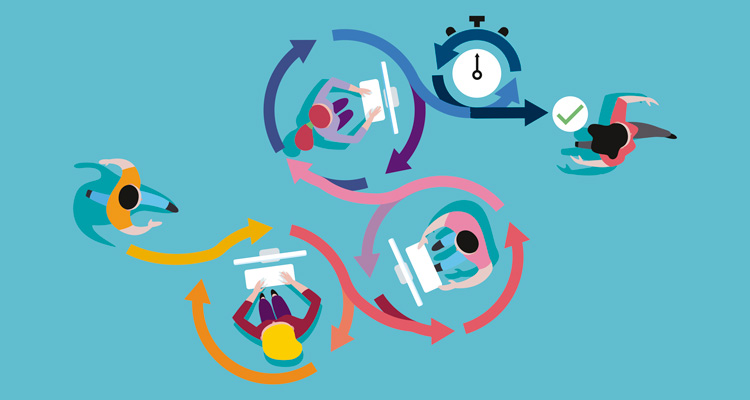
The role of leadership in a Lean-Agile transformation certainly isn’t easy. While most enterprise leaders are likely familiar with the basic concepts of Lean and Agile, practicing them is another thing entirely. Leaders are often tasked with learning Lean-Agile practices while actively demonstrating them for everyone in the organization.
The pressure is on for leadership to understand, practice, and share openly about both successes and failures in their Lean-Agile practice. This is not to say that leaders have to be perfect, for the concept of ‘perfection’ itself goes against the iterative approach of Agile. But they do have to be honest, humble, and proactive in order to give their transformation a fighting chance.
If you’re a leader in an organization looking to undergo a Lean-Agile transformation, this post is for you. Here are five potential pitfalls to be aware of during your transformation—and tips for how to avoid them.
Potential Pitfalls in Your Lean-Agile Culture Shift (and How to Avoid Them)
1. You rely too heavily on Foosball tables and an open vacation policy.
One of the greatest challenges facing enterprises today is attracting the right kind of talent—those smart, ambitious, customer-driven, open-minded employees who thrive in a Lean-Agile environment. Another great challenge is keeping them.
Employees no longer spend their entire careers climbing the ladder at one company. Forrester Research predicts that the average employee entering the job market today will hold between twelve to fifteen jobs in their lifetime. Workers are more empowered than ever to pursue jobs that challenge them intellectually, fulfill them personally, and provide for them (financially and otherwise) in unprecedented ways.
Once seen as luxuries afforded to only a lucky few, perks like unlimited time off, catered lunches, craft beers on tap, dog-friendly offices, gym memberships, and more, are now becoming table stakes, especially in industries like tech.
In order to compete for talent with disruptive, well-funded startups, enterprises have begun offering similar, trendy perks, with varying degrees of success (the realities of unlimited PTO, for example, can be less desirable for employees than employers often realize).
The problem is that, much like implementing the practices of Lean and Agile without a shared understanding of the why, offering these perks without a fundamental shift in organizational culture is an expensive and short-sighted endeavor.
While such changes are often appreciated by candidates, it’s important to understand that these “benefits” represent a fundamental difference in organizational culture, which is more valuable to employees than a few shiny perks.
Enterprise leaders can work to avoid this pitfall by focusing their efforts on developing a culture that actively, consistently benefits employees and customers, not by just adding benefits.
2. You assume it will happen quickly.
Lean-Agile culture shifts don’t happen quickly—no culture shift does. As Steve Denning explains, “The elements of a culture fit together as a mutually reinforcing system and combine to prevent any attempt to change it. Single-fix changes at the team level thus may appear to make progress for a while, but eventually the interlocking elements of the organizational culture take over and the change is inexorably drawn back into the existing organizational culture.”
Transforming a culture meaningfully requires time, consistent effort, and accountability. “This isn’t like fixing a car where if you fix a tire, the tire stays fixed,” Denning continues. “Instead the organization acts more like an ingeniously morphing virus that steadily adapts itself to, and ultimately defeats intended fixes and returns to its original state, sometimes more virulent than before.”
To avoid this potential pitfall, dedicate ample time (6-12 months) to actively working on supporting your organization’s Lean-Agile transformation. Hire or dedicate a team specifically to developing the organization’s Lean-Agile practice to encourage Lean-Agile education, facilitate change management, and ensure the sustainability of your efforts. Investing this time and energy upfront will help to ensure the success of your initiative.
3. You don’t invest enough in Lean-Agile education.
We’ve written a lot lately about the importance of a shared Lean-Agile mindset in Lean-Agile transformations. The emphasis on mindset, over practices or rules, is what makes Lean and Agile difficult to implement. It’s also why Agile has stood the test of time compared to other business practices. Because of the focus on the human dimension/mindset over processes and practices, Agile is able to continuously evolve and grow in ways that many of the other 20th century management practices (in some cases fads) could not, welcoming other ideas like Lean thinking, design thinking, DevOps, and more.
What’s missing from ‘failing’ implementations of Lean and Agile is the understanding that in order to see radically different outcomes, you have to create a radically different culture—which starts with a shared understanding of the fundamental values of Lean and Agile.
More than anything else, fostering those more nuanced, ‘soft skill’, Lean-Agile competencies throughout your organization is critical for the long-term sustainability of your transformation.
4. You don’t plan to face resistance.
Another common pitfall in Lean-Agile implementations is a lack of preparation for how to productively handle resistance. Resolving the tensions between Agile and traditional management cannot usually be achieved by purely rational means. That’s because those in management roles have often built their entire careers around the deep emotional attachments, attitudes, values, and views that make up a corporate culture. They’ve been taught from early in their careers how to establish their presence in a company and ‘climb the ladder’ and pursue profitability and ROI at all costs. They like being “the boss.” They derive comfort, pride, and self-esteem from being the “superior” of others.
Our experience shows that trying to convince such managers with hard financial data that delighting the customer will make them more profitable simply won’t work—especially since their role as a boss is embedded in the organization’s culture which comprises an interlocking set of goals, roles, processes, values, communications practices, attitudes, and assumptions. Even if a manager would personally prefer to embrace the customer, the culture itself often makes it difficult to change.
In order to persuade managers to stop acting like “superiors” and embrace Agile fully, you have to connect with them on a deeper emotional level through experiences and leadership storytelling. Steve Denning says you have to, “…enable them to embrace a different set of attachments, attitudes, values and understanding about how the world works. The manager must, in effect, fall in love with the customer.”
5. You don’t evolve your hiring practices.
Part of failing to plan for resistance is not recognizing the reality that some people simply aren’t well-suited for a Lean-Agile environment. Traditionally, hiring practices focused on identifying candidates that had specific, easily defined characteristics: X years of experience, a certain type of degree or certification, or experience with a specific tool.
However, success in a Lean-Agile environment requires more than having a fancy degree or even the right technical skills for the job. Thriving in a fast-paced, ambitious, team-oriented, customer-focused workplace requires a personality that is open-minded, flexible, collaborative, and comfortable with constant change. It’s not for everyone.
Often, organizations looking to become more Lean and Agile fail to incorporate these values into their hiring practices, and so culture, as Denning described above, tends to mutually reinforce itself.
It’s up to leaders to prioritize the development hiring practices that effectively identify candidates well-suited for a Lean-Agile environment. Prioritize Lean-Agile experience, strong interpersonal skills, and a willingness to learn over years of experience, degrees, or other ‘merits.’
6. You don’t get the right tools for the job.
Lean-Agile initiatives aim to increase transparency, accountability, and collaboration between disparate value streams, as well as internal and external stakeholders. Often, one of the primary contributors to a lack of visibility across the enterprise is the fact that different teams ‘live’ in different tools day to day. Collaboration with teams beyond their most frequent co-collaborators requires significant administrative overhead.
Enterprise leaders have to lead the effort to connect the dots between disparate tools, which will require more than just a simple tool swap. Often, organization-wide efforts to optimize the whole result in a sub-optimization of the various parts. Put another way, trying to get dev teams and marketing teams to use the same tools to manage their work will likely make everyone less productive.
Instead, leaders should think across the value stream, and gather data directly from the source: Those actually doing the work. With the goal of increasing self-sufficiency in teams, promoting knowledge sharing, and developing informed, invested servant leaders, leaders should look for innovative, integrated solutions that allow for visibility and collaboration without sacrificing efficiency.
7. You don’t plan to also make a fundamental shift in the organizational structures that are meant to support Lean-Agile principles.
In a poll of some 400 people working in many different firms where the practices known as Agile and Scrum are being implemented, 88% reported tension between the way Agile/Scrum teams are managed in their organization and the way the rest of the organization is managed. Only 8% reported “no tension.”
It’s true that you can’t talk the Agile talk without walking the walk. Although we discuss the shift to Lean-Agile as cultural, it will require practical, structural changes, which are a harder sell, especially in those business units who provide the very structure that Lean-Agile transformations tend to disrupt: HR, finance, and others.
Get Started
The best thing you can do as an emerging Lean-Agile leader is to approach the process with honesty, vulnerability, and transparency—to set an example that encourages others to pursue the messy, but meaningful growth required to create lasting change. Learn as much as you can about Lean and Agile and create opportunities for others to do the same.
To learn more about the Lean-Agile culture shifts required for organizational agility, read the eBook , “Why Lean-Agile Culture Shifts Fail.”







